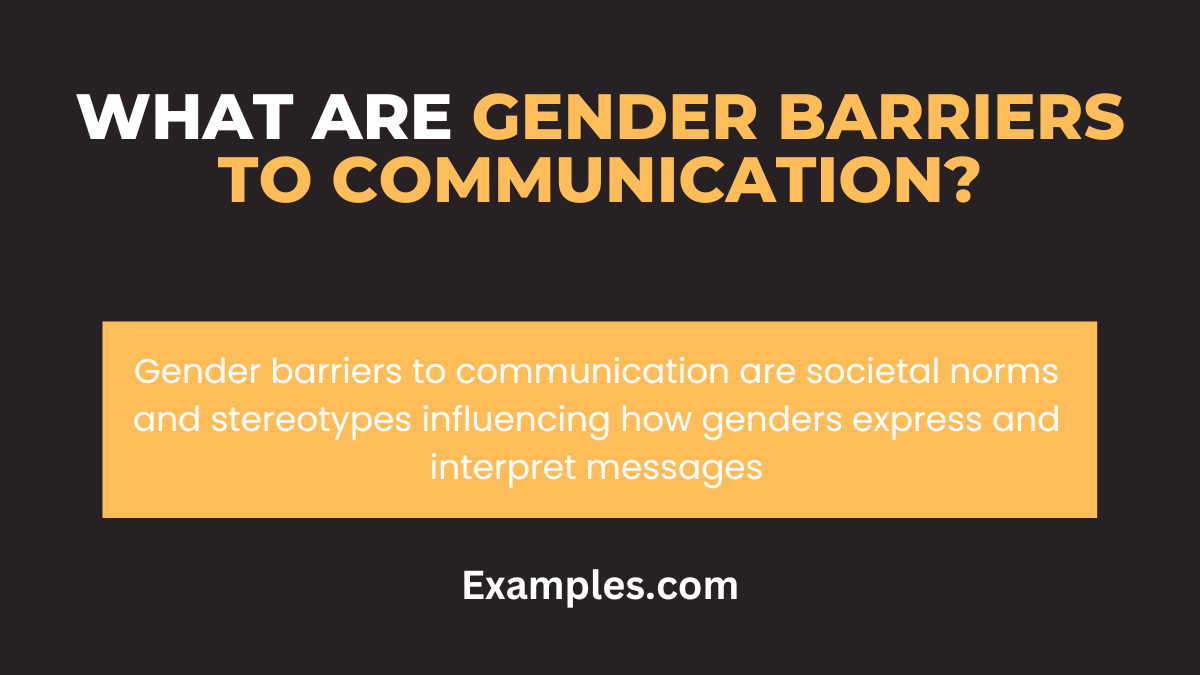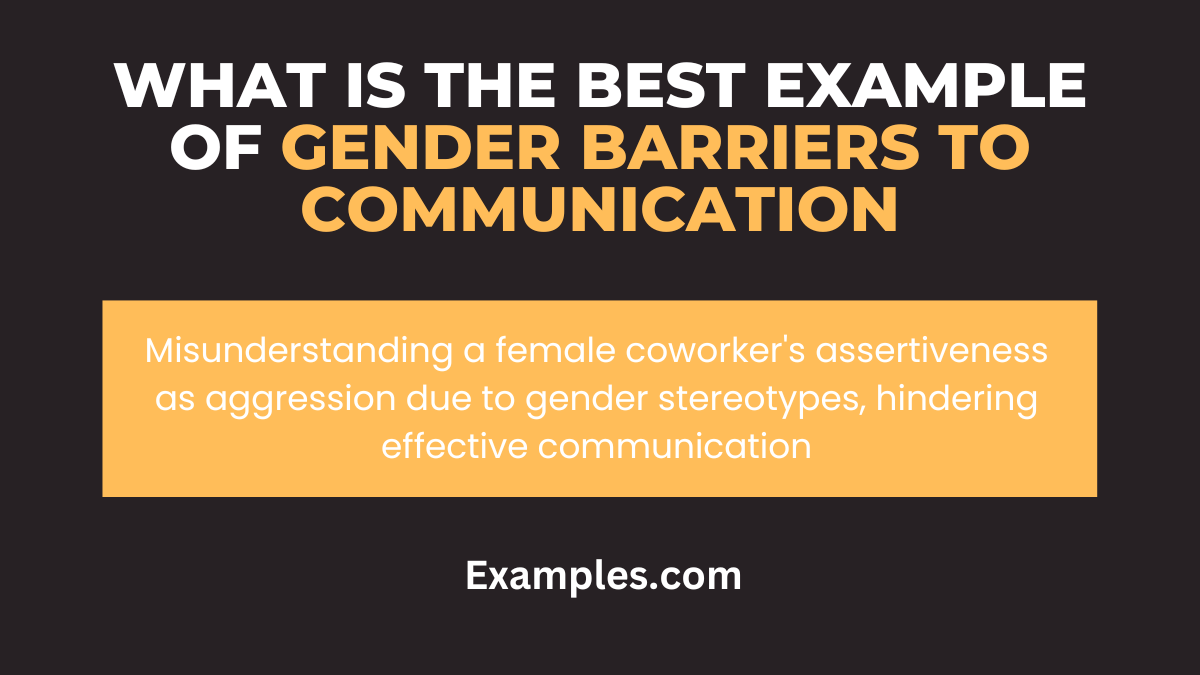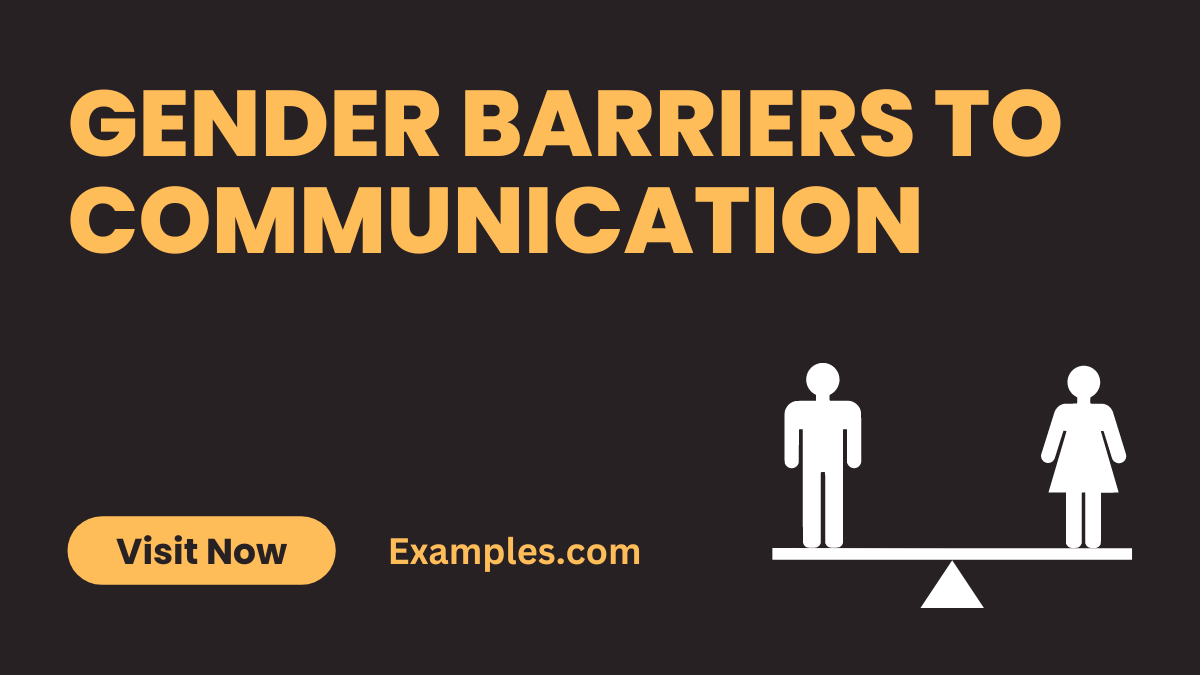19+ Gender Barriers to Communication Examples
In our ever-evolving world, understanding and overcoming “Gender Barriers to Communication” is crucial. This comprehensive guide delves into the nuances of gender dynamics in communication, offering insightful tips and strategies to navigate these challenges. Whether in professional settings or personal interactions, recognizing and addressing these barriers is key to fostering effective and inclusive communication. Here, we explore various aspects of gender barriers, providing you with the knowledge and tools to enhance your communication skills across diverse contexts.
What are Gender Barriers to Communication?

Gender barriers to communication arise from differences in how various genders perceive, interpret, and convey messages. These barriers can stem from societal norms, cultural expectations, and personal biases, often leading to misunderstandings or misinterpretations. Understanding these barriers is the first step towards building a more inclusive and effective communication environment.
What is the Best Example of Gender Barriers to Communication?

A classic example of gender barriers in communication is the difference in conversational styles. Typically, men are observed to communicate more directly and assertively, while women often adopt a more collaborative and empathetic approach. This contrast can lead to misinterpretation of intentions or underestimation of assertiveness or empathy in professional and personal interactions.
20 Examples of Gender Barriers to Communication

Gender barriers in communication are pervasive issues that stem from stereotypical beliefs, language biases, and societal norms. These barriers often result in miscommunication, exclusion, and unequal opportunities across genders. Understanding and addressing these barriers is crucial for fostering inclusive, effective communication in diverse settings, whether in professional environments or personal interactions. Recognizing these challenges is the first step towards more equitable communication practices.
- Assuming Leadership Based on Gender: Believing that only a specific gender is suitable for leadership roles can hinder open communication.
Example: “Let’s let him lead the discussion, he probably has more experience.” - Gender-Specific Language: Using gender-specific terms can exclude or stereotype individuals.
Example: “Hey guys, let’s focus on the task.” - Underestimating Based on Gender: Assuming a person’s capabilities based on their gender limits their contribution.
Example: “This task might be too technical for her.” - Interrupting or Ignoring Contributions: Often, one gender may dominate conversations, overlooking the other’s input.
Example: “I think we’ve heard enough, let’s move on.” - Stereotyping Communication Styles: Attributing a particular communication style to a gender can lead to misunderstandings.
Example: “Women are always so emotional in discussions.” - Gender-Biased Feedback: Giving feedback based on gender stereotypes rather than actual performance.
Example: “You’re quite assertive for a woman.” - Exclusion from Informal Networks: Informal networks often form along gender lines, excluding others.
Example: “The guys usually discuss this after work, you wouldn’t be interested.” - Overlooking Gender Diversity: Not recognizing or respecting gender diversity in communication.
Example: “We don’t need to worry about gender pronouns here.” - Gender-Based Assumptions in Decision Making: Assuming interests or decisions based on gender.
Example: “Let him handle the budget; it’s more of a man’s job.” - Disparaging Comments Based on Gender: Making derogatory remarks about a gender affects communication.
Example: “That’s such a woman’s way of looking at it.” - Lack of Gender-Sensitive Training: Not providing training that addresses gender communication differences.
Example: “Our communication training doesn’t focus on gender issues.” - Bias in Assigning Roles: Assigning roles based on gender stereotypes limits potential.
Example: “Let her handle the event planning; women are good at that.” - Overgeneralizing Gender Traits: Assuming all individuals of a gender possess certain traits.
Example: “All men are straightforward in their communication.” - Ignoring Gender-Related Challenges: Overlooking the unique communication challenges faced by different genders.
Example: “Gender doesn’t really affect our team dynamics.” - Unequal Opportunities for Voice: Providing more opportunities for one gender to voice opinions over another.
Example: “Let’s hear from the men first on this issue.” - Gender Discrimination in Feedback: Giving biased feedback based on gender.
Example: “You could be a bit softer in your approach, like most women.” - Inequity in Encouraging Participation: Encouraging one gender over another to participate in discussions.
Example: “We need more male perspectives on this.” - Cultural Norms Dictating Gender Roles: Cultural expectations influencing gender roles in communication.
Example: “In our culture, women don’t usually speak up in meetings.” - Lack of Representation in Leadership: A lack of diverse gender representation in leadership can impact communication styles.
Example: “Our leadership team is predominantly male, so they set the communication tone.” - Gender-Specific Expectations in Tone: Expecting a certain communication tone based on gender.
Example: “As a man, you should be more assertive in your communication.
Gender Barriers to Communication in Healthcare
- Stereotyping and Assumptions: Healthcare professionals may unconsciously hold gender stereotypes, leading to assumptions about a patient’s knowledge, abilities, or health concerns.
- Differences in Communication Styles: Men and women often have different ways of expressing themselves, which can lead to misunderstandings in patient-provider interactions.
- Bias in Medical Research: Historical medical research has often focused on male subjects, potentially overlooking gender-specific symptoms or conditions.
- Disparity in Health Education: Women’s health issues, especially reproductive health, are sometimes less emphasized, leading to gaps in understanding and communication.
- Power Dynamics: Traditional gender roles can influence the power dynamics in healthcare settings, affecting the patient’s comfort in discussing health concerns openly.
How to Overcome Gender Barriers of Communication?
- Cultivate Gender Sensitivity: Educate healthcare providers on the importance of understanding and respecting gender differences in communication.
- Encourage Open Dialogue: Create an environment where all patients feel comfortable discussing their health concerns without judgment.
- Patient-Centered Approach: Focus on individual patient needs rather than relying on gender-based assumptions.
- Diversify Health Education: Include comprehensive information on both men’s and women’s health issues in medical training.
- Regular Bias Training: Implement regular training sessions to help healthcare professionals recognize and overcome their biases.
Gender Barriers to Communication at Workplace
- Leadership Stereotypes: Traditional views on leadership often favor masculine traits, which can limit women’s opportunities for leadership roles.
- Differing Communication Styles: Men and women may have varying communication styles, leading to misinterpretations and conflicts in a professional setting.
- Gender-Based Language: The use of gendered language in the workplace can inadvertently exclude or diminish certain groups.
- Lack of Gender Diversity: Predominantly male or female workplaces can reinforce gender norms, making it difficult for the minority gender to communicate effectively.
- Unconscious Bias: Unconscious biases can influence how colleagues perceive and interact with each other based on gender.
Gender barriers in communication is essential for fostering inclusive and effective interactions. This article has provided valuable insights and tips on overcoming these barriers. By promoting empathy, active listening, and awareness of biases, individuals and organizations can create a more equitable and open communication environment, ultimately benefiting both personal and professional relationships.



